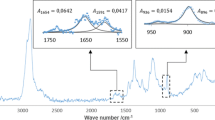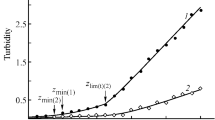Abstract
The study is devoted to estimation of the effect of quaternization on the molecular properties of polysaccharide chitosan. Solution properties of quaternized chitosan derivative, N-[(2-hydroxy-3-trimethylammonium)propyl]chitosan, have been studied in comparison with the initial chitosan in 0.33М СН3СООН + 0.2М CH3СООNa. The averaged quaternization degree of the modified samples was (90 ± 5) %. Hydrodynamics methods, translation isothermal diffusion and viscometry, and static/dynamic light scattering were applied for characterization of two homologues series of chitosans. The equilibrium chain rigidity value and Mark–Kuhn–Houwink relationships for intrinsic viscosity and diffusion coefficient have been received for the both polysaccharides at pH 3.54 and high ionic strength value. A change of thermodynamic conditions in the same solvent was detected for the modified chitosan in relation to initial analog. Even though the side substituents length is longer for the modified polysaccharide, the hydrodynamic dimension of its molecules could be smaller than initial polysaccharide of the same polymerization degree due to nonequivalent contributions of thermodynamic/electrostatic interactions to the total chain rigidity. The hydrodynamic behavior of quaternized chitosan in 0.33М СН3СООН + 0.2М CH3СООNa has been compared to its behavior in 0.2 M NaCl. The influence of the secondary amino group protonation on hydrodynamic properties of modified chitosan molecules was detected at neutral pH. Solution properties of quaternized chitosan in 0.2 M NaCl were identified as the concentration dependent.







Similar content being viewed by others
References
Muzarelli RAA, Muzarelli C (2005) Chitosan chemistry: relevance to the biomedical sciences. Adv Polym Sci 186:151–209
Runarsson OV, Holappa J, Nevalainen T, Hjalmarsdottir M, Jarvinen T, Loftsson T, Einarsson JM, Valdimarstdottir M, Masson M (2007) Antibacterial activity of methylated chitosan and chitooligomers: sythesis and structure activity relationships. Eur Polym J 43(6):2660–71
Jia ZS, Shen DF, Xu WL (2001) Synthesis and antibacterial activities of quaternary ammonium salt of chitosan. Carbohydr Res 333(1):1–6
Xu T, Xin M, Li M, Huang H, Zho S, Liu J (2011) Synthesis, characterization and antibacterial activity of N, O-quaternary ammonium chitosan. Carbohydr Res 346(15):2445–50
Avadi MR, Sadeghi AMM, Tahzibi A, Bayati K, Pouladzaeh M, Zohuriaan-Mehr MJ, Rafiee-Tehrani M (2004) Diethylmethyl chitosan as an antimicrobial agent: synthesis, characterization and antibacterial effects. Eur Polym Jnl 40:1355–61
Wang JJ, Zeng ZW, Xiao RZ, Xie T, Zhoo GL, Zhan XR, Wang SL (2011) Recent advances of chitosan nanoparticles as drug carriers. Int J Nanomedicine 6:765–74
Mao S, Sun W, Kissel T (2010) Chitosan-based formulations for delivery of DNA and siRNA. Adv Drug Del Rev 62(1):12–27
Tong H, Qin S, Fernandes JC, Li L, Dai K, Zhang X (2009) Progress and prospects of chitosan and its derivatives as nonviral gene vector in gene therapy. Current Gene Therapy 9(6):495–502
Belatia R, Grelier S, Benassia M, Coma V (2008) New bioactive biomaterials based on quaternized chitosan. J Agric Food Chem 56(5):1582–88
Lim SH, Hudson SM (2004) Application of fiber-reactive chitosan derivative to cotton fabric as an antimicrobial textile finish. Carbohydr Polym 56(2):227–34
Sieval AB, Thanou M, Kotze AF, Verhoef JC, Brussee J, Junginger HE (1998) Preparation and NMR characterization of highly substituted N-trimethylchitosan chloride. Carbohydr Polym 36(2–3):157–65
Muzarelli RAA. In: Aspinall GO, editor (1985) The Polysaccharides. NY: Academic Press. p.3
Gamzazade AI, Shlimak VM, Sklyar AM, Stykova EV, Pavlova SSA, Rogozhin SV (1985) Investigation of the hydrodynamic properties of chitosan solutions. Acta Polymerica 36(3):420–24
Pogodina NV, Pavlov GМ, Bushin SV, Melnikov АB, Lisenko ЕB, Marsheva VN, Marchenko GN, Tsvetkov VN (1986) Conformational characteristics of chitosan molecules according to diffusion-sedimentation and viscometry data. Polym Sci, Ser A 28(2):251–59
Rinaudo M, Domard A (1989) Chitin and chitosan. Elsevier Applied Sciences, London, pp 71–86
Buhler E, Rinaudo M (2000) Structural and dynamical properties of semirigid polyelectrolyte solution: a light scattering study. Macromolecules 33(6):2098–2106
Kim YH, Nam CW, Choi JW, Jang J (2003) Durable antimicrobial treatment of cotton fabrics using N-(2-hydroxy)propyl-3-trimethylammonium chitosan chloride and polycarboxylic acids. J Appl Polym Sci 88(6):1567–72
Qin CQ, Xiao Q, Li HR, Fang M, Liu Y, Chen XY, Li Q (2004) Calorimetric studies of the action of chitosan- N-2 ydroxypropyltrimethyl ammonium chloride on the growth of microorganizms. of. Int J Biol Macromol 34(1–2):121–26
Faizuloev EB, Marova AA, Nikonova AA, Volkova IF, Gorshkova MY, Izumrudov VA (2012) Water-soluble N-[(2-hydroxy)propyl-3-trimethylammonium)propyl]chitosan chloride as nucleic acid vector for cell transfection. Carbohydr Polym 89(4):1088–94
Huang M, Khor E, Lim LY (2004) Uptake and cytotoxicity of chitosan molecules and nanoparticles: effect of molecular weight and degree of deacetylation. J Pharm Res 21(2):344–53
Gorshkova МY, Volkova IF, Alexeeva SG, Molotkova NN, Skorikova ЕЕ, Izumrudov VА (2011) Water-soluble modified chitosan and its interaction with polystyrenesulfonate anion. Polym Sci, Ser A 53(1):67–74
Lim SH, Hudson SM (2004) Synthesis and antimicrobial activity of water-soluble chitosan derivative with a fiber-reactive group. Carbohydr Res 339(2):313–19
Tsvetkov VN (1989) Rigid-chain polymers. Plenum, Consultans Bureau, New York
Lam L, Lee SW, Suen CY (1992) IEEE transactions on pattern analysis and machine intelligence. Thinning Methodologies. A Comprehensive Survey 14(9):879–85
Chu B (2007) Laser light scattering - basic principles and practice. Dover Publication, New York
Yevlampieva NP, Gorshkova МY, Volkova IF, Grigorjan ES, Khurchak АP, Rjumtsev ЕI (2011) Molecular properties of modified chitosan containing quaternary amino groups. Polym Sci, Ser A 53(2):124–32
Rinaudo M, Pavlov G, Desbrieres J (1999) Influenece of acetic acid concentration on solubilization of chitosan. Polymer 40(25):7029–32
Flory PJ (1989) Statistical mechanics of chain molecules. Interscience, New York
Yamakawa H, Fujii M (1973) Translation friction coefficient of wormlike chains. Macromolecules 6(3):407–415
Esquenet C, Buhler E (2001) Phase behavior of assosiating polyelectrolyte polysaccharides. 1. Aggregation process in dilute solution. Macromolecules 34(15):5287–94
Acknowledgments
The authors are thankful to the Сentre for Diagnostics of Functional Materials for Medicine, Pharmacology, and Nanoelectronics of Saint Petersburg State University for support with the static and dynamic light scattering measurements, and for performing of pH measurements.
Author information
Authors and Affiliations
Corresponding author
Rights and permissions
About this article
Cite this article
Yevlampieva, N.P., Gubarev, A.S., Gorshkova, M.Y. et al. Hydrodynamic behavior of quaternized chitosan at acidic and neutral pH. J Polym Res 22, 166 (2015). https://doi.org/10.1007/s10965-015-0802-7
Received:
Accepted:
Published:
DOI: https://doi.org/10.1007/s10965-015-0802-7




